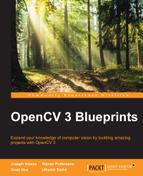This chapter has demonstrated a set of surprisingly flexible commands and classes, which enable us to conduct experiments in computational photography, with short and simple code. We have written scripts to control a photo camera. Along the way, we have acquainted ourselves with gPhoto2, the Bash shell, PTP communication, GVFS mount points, and Python's support for subprocesses. We have also scripted several variations of a photo trap to take pictures when a subject comes into view. For this, OpenCV has provided us with the capability to detect motion, measure color similarities, and classify objects. Finally, we have used OpenCV to combine a set of photos into a time-lapse video or HDR image.
So far, this book has provided a fairly broad survey of ways to capture light as data, control a camera, detect a subject, and process a photo. The remaining chapters will focus on a selection of advanced techniques, which will enable us to perform much finer classification and identification of an image's subject, and to process photos and videos in ways that account for camera motion and perspective.
